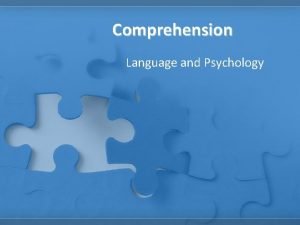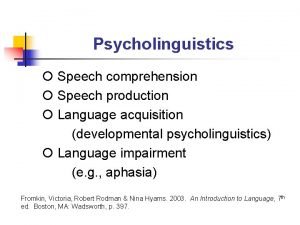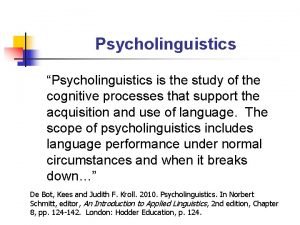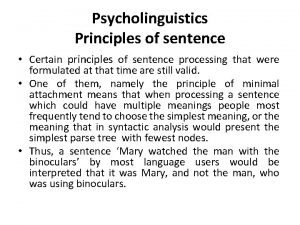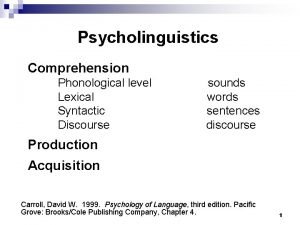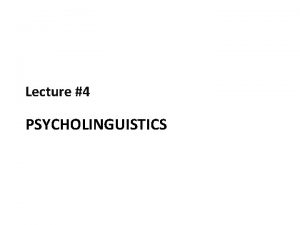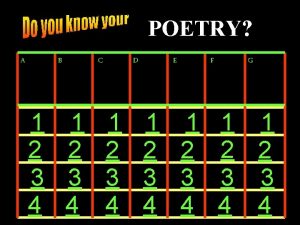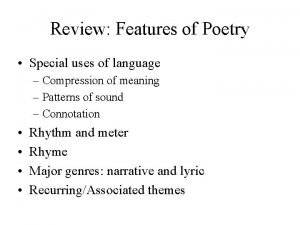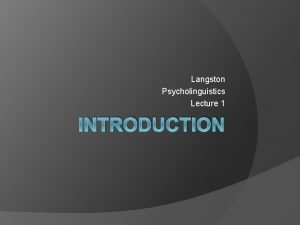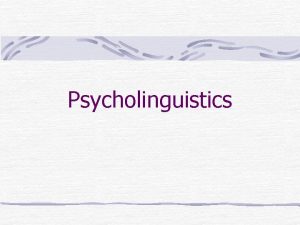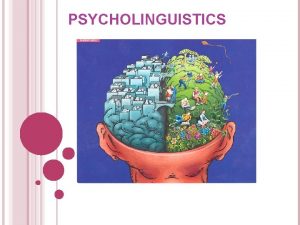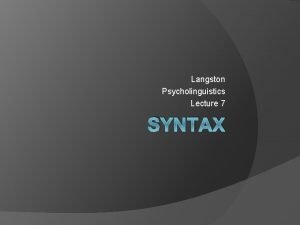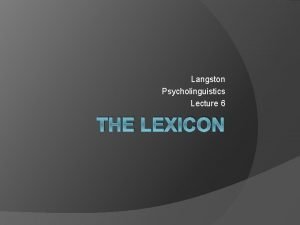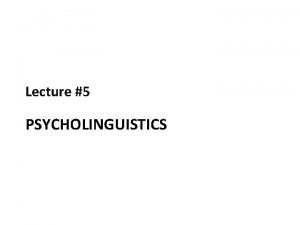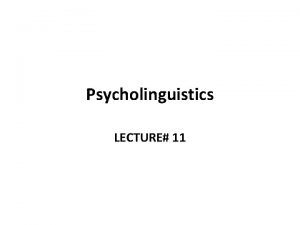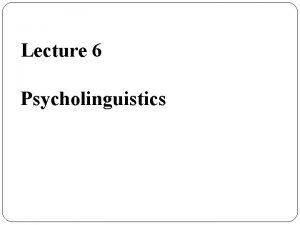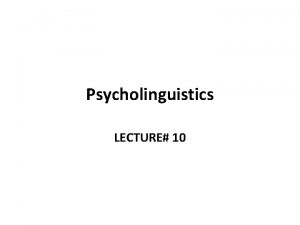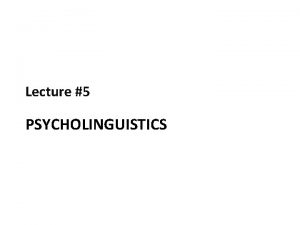Langston Psycholinguistics Lecture 4 SPEECH PRODUCTION Speech Production






































- Slides: 38

Langston Psycholinguistics Lecture 4 SPEECH PRODUCTION

Speech Production Interchangeability: “individuals who use a language can both send and receive any permissible message within that communication system”

https: //www. youtube. com/watch? v=dw. H p. Bw. Ax. DIs

Speech Production Questions: Model for speech production? Grammar for speech production? Does this affect our thinking about explanations for speech perception?

Speech Production Model: The data for understanding production are errors. Common types: Shift: One segment moves from its appropriate location. “That's so she'll be ready in case she decide to hits it. ” Exchange: Two units change place. “Fancy getting your model renosed. ”

Speech Production The data for understanding production are errors. Common types: Anticipation: A segment is produced too early. “Go ahead, bake my bike. ” Perseveration: A segment gets repeated. “He pulled a pantrum. ” Addition: Add a segment. “I didn't explain this clarefully enough. ”

Speech Production The data for understanding production are errors. Common types: Deletion: A segment gets left out. “I'll just get up and mutter __intelligibly. ” Substitution: Substitute a related segment for the intended segment. “At low speeds it's too light. ” Blends: Two possible segments become blended. “That child is looking to be spaddled. ”

Speech Production Errors occur at all levels (phonological, morphological, syntactic). Don't usually bridge levels (e. g. , phonological errors in syntactically correct sentences).

Speech Production Common properties of errors: Elements that interact come from similar environments (e. g. , ends swap with ends). Elements that interact tend to be similar (e. g. , consonants with consonants). Errors that produce novel linguistic items are still consistent with other rules. Errors have same stress pattern as correct.

Speech Production Sources of errors: Freudian: Errors represent something “leaking out” of the unconscious. ○ “Good morning beheaded…er, beloved. ” ○ Bine foddy. Psycholinguistic: Speech production is hard work and cognitively taxing. Errors are to be expected.

Speech Production model: 1. Conceptualize: 2. Form a linguistic plan: a. Identify meaning: Find definitions that match the thought. b. Select syntactic structure: Generally SVO, but English has a variety of sentence plans. Choose the one that fits.

Speech Production model: 2. Form a linguistic plan: c. Generate an intonation contour: Stress pattern. “Why would Jerry bring anything? ” vs. “Why would Jerry bring anything? ” Or play this example. d. Insert content words. e. Form affixes and function words.

Speech Production model: 2. Form a linguistic plan: f. Specify phonetic segments. g. Edit: Check for basic errors.

Speech Production BALL DOZE BASH DOOR BEAN DECK BELL DARK DARN BORE

Speech Production BIG DUTCH BANG DOLL BILL DEAL BARK DOG DART BOARD

Speech Production model: 2. Form a linguistic plan: ○ Errors support dividing into these steps. “Stop beating your brick against a head wall. ” (stage d) ○ Errors support the sequence. “It certainly run outs fast. ” If /s/ on out, then phonetic after affixes. If /z/ then affixes after phonetics.

Speech Production model: 3. Implement the plan. ○ Planning and production appear to go in cycles.

Speech Production Roberts & Kirsner (2000):

Speech Production model: 3. Implement the plan. ○ This is generally taken to reflect working memory limitations. Planning is expensive, so you can't get an entire sentence at once.

Speech Production model: 4. Self-monitoring. In addition to the error checking in the planning step. Selfinterruption. Signal that you have spotted an error.

Speech Production

Speech Production model: 4. Self-monitoring. a. Interruptions: • Within a word: “We can go straight on to the ye, er pink. ” 18% • After a word: “Straight on to green- to red. ” 51% • Later: “and from green left to pink, er from blue left to pink. ” 31% b. Interrupt with an editing expression (e. g. , “uh”).

Speech Production model: 4. Self-monitoring. c. Self-repair. Fix the problem.

Speech Production Grammar: Set of elements (phonetic features). Rules for combining those elements. (The following is from Fernández & Cairns, 2011)

Speech Production Grammar: For example: ○ /p/ in the initial position of a stressed syllable is aspirated. Apart, important, apple, spin. ○ Flap /t/ and /d/ between two vowels and in the onset of an unstressed syllable. Writing, riding, matter, madder. Fatter, faster, city, baton, potato.

Speech Production Grammar: Also possible sequences constrained (syllables): Nucleus: Vowel. ○ Onset: Syllable initial consonants. ○ Coda: Final consonants. ○ Rime: Nucleus + coda. ○

Speech Production Grammar: Also possible sequences constrained (syllables): All languages have syllables with vowels. ○ All languages have syllables with a consonant followed by a vowel. ○ English unrestricted for syllable-final consonants, some languages more restricted. ○

Speech Production Grammar: Also possible sequences constrained (syllables): English won't allow syllables to begin with /dl/ or /tl/. ○ Etc. ○

Speech Production Grammar: (From Pinker) Ping-pong vs. pong-ping: High-front vowels come before low-back vowels. Other phonetic symbolisms (p. 163).

Speech Production Grammar: (From Pinker, p. 169) Ptak, thale, hlad, plaft, sram, mgla, vlas, flutch, dnom, rtut, toasp, nyip Which ones could be English? English allows some consonant clusters in onsets (e. g. , /pl/) but not others (e. g. , /vl/). Japanese rimes must have a bare vowel (strawberry = sutoroberi).

Speech Production Grammar: (From Pinker, p. 173) I is longer before voiced than unvoiced consonants (e. g. , ride vs. write). This rule is applied before flapping rule. Spreading voicelessness. p. 175: Features are what are the unit, not phonemes. p. 177: Note parity and interchangeability: Laziness of speakers counteracted by need for clarity for listeners.

Speech Production Does our discussion of production affect our decision-making about models of perception? Direct realism. FLMP. Motor theory.

Speech Production Is our discussion of production affected by our discussion of perception? Direct realism. FLMP. Motor theory.

Speech Production Fox Tree & Tomlinson (2008; doi: 10. 1080/01638530701739280) Not really speech production per se, but production. “Like” (be + like) has risen in frequency relative to “said” to mark quotations: ○ “I was like 'You should hotwire the bus'” (p. 85).

Speech Production Fox Tree & Tomlinson (2008, p. 92): Variable 1980 s 2000 s Said 85% 7% Like 4% 92% Goes 11% 2%

Speech Production Fox Tree & Tomlinson (2008): Why? Like indicates unfaithful quotation, said implies accuracy. ○ “She's like, 'blah, blah'” (p. 89). Like does things that said can't: ○ ○ Convey thoughts as well. “And he would use that excuse, and I'm like, 'What are you talking about? '” (p. 100). “Mimic vocal effects, sound effects, or gestures in a way that said cannot. ” “He was like opening his drawers but they were stuck so he was like, 'Raah aah'” (p. 100).

Speech Production Fox Tree & Tomlinson (2008): Why? The data supported the second possibility. “Like” has gained in popularity because it does more.

THE END
 Apa itu pre-production?
Apa itu pre-production? 01:640:244 lecture notes - lecture 15: plat, idah, farad
01:640:244 lecture notes - lecture 15: plat, idah, farad Scope of psycholinguistics
Scope of psycholinguistics Comprehension psychology
Comprehension psychology The scope of psycholinguistics
The scope of psycholinguistics Developmental psycholinguistics
Developmental psycholinguistics Psycholinguistics
Psycholinguistics Psycholinguistic aspects of interlanguage
Psycholinguistic aspects of interlanguage Comprehender adalah
Comprehender adalah Psycholinguistics psychology definition
Psycholinguistics psychology definition History of psycholinguistics
History of psycholinguistics What is psycholinguistics
What is psycholinguistics Psycholinguistics aspects of interlanguage
Psycholinguistics aspects of interlanguage History of psycholinguistics
History of psycholinguistics What is the scope of psycholinguistics
What is the scope of psycholinguistics Interlanguage in psycholinguistics
Interlanguage in psycholinguistics Language loss in psycholinguistics
Language loss in psycholinguistics Language a
Language a Comprehension of words in psycholinguistics
Comprehension of words in psycholinguistics Examples of psycholinguistics
Examples of psycholinguistics Dreams by langston hughes summary
Dreams by langston hughes summary Langston hughes fine clothes to the jew
Langston hughes fine clothes to the jew What is the theme for theme for english b
What is the theme for theme for english b Words like freedom by langston hughes
Words like freedom by langston hughes Ballad of booker t
Ballad of booker t شعر abcdefg
شعر abcdefg Salvation langston hughes questions
Salvation langston hughes questions Talk about a family eloise greenfield
Talk about a family eloise greenfield Langston hughes character traits
Langston hughes character traits Language techniques
Language techniques Tpcastt examples
Tpcastt examples A noiseless patient spider paraphrase
A noiseless patient spider paraphrase Thank you ma'am by langston hughes summary
Thank you ma'am by langston hughes summary Langston hughes 5 character traits
Langston hughes 5 character traits Thank you mam
Thank you mam Dreams by langston hughes figurative language
Dreams by langston hughes figurative language Slant rhyme definition
Slant rhyme definition Langston hughes april rain song
Langston hughes april rain song Dreams langston hughes meaning
Dreams langston hughes meaning



